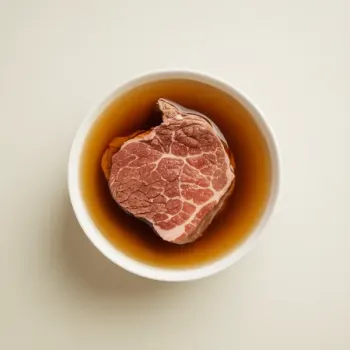Vegetable Broth vs Beef Broth are cooking liquids; vegetable broth is light and suitable for vegetarian dishes, while beef broth is rich, adding umami to heartier meals.

Vegetable broth is a flavorful liquid made by simmering vegetables, herbs, and sometimes spices in water. It's a versatile base for soups, stews, sauces, and other vegetarian dishes, providing a light and healthy foundation that enhances the natural flavors of the ingredients.

Beef broth is a rich and savory liquid made by simmering beef, bones, vegetables, and herbs in water. It adds depth and a robust meaty flavor to dishes, making it an essential ingredient in hearty soups, stews, gravies, and braises that require a strong, umami-packed base.
Vegetable broth offers a light, fresh taste with subtle layers of flavor from various vegetables, while beef broth has a bold, savory taste with a rich texture from the gelatin released by simmering bones.
Vegetable broth is plant-based, making it suitable for vegetarians and those looking for a lower-calorie option. Beef broth, made from animal products, contains more protein and amino acids but is also higher in fat.
Vegetable broth is ideal for light soups, risottos, and as a poaching liquid, whereas beef broth is better suited for more robust dishes like beef stews, French onion soup, and for braising meats.

Your ultimate Recipe Box, Meal Planner, and Cooking Class all in one
Use vegetable broth in minestrone, vegetable puree soups, or light noodle soups. It provides a gentle backdrop that allows the flavors of fresh vegetables to shine. Best for French onion soup, beef barley soup, or any soup that demands a hearty, meaty base. Beef broth adds a depth of flavor that enriches the overall taste of the soup.
Opt for vegetable broth in stews with pulses like lentils or chickpeas, and for braising vegetables like eggplant or zucchini, to keep them light yet flavorful. Use beef broth for beef stews, osso buco, or short ribs. Its richness complements the flavors of the meat and helps to create a velvety sauce or gravy.
Vegetable broth is perfect for cooking grains like quinoa or rice, lending a subtle flavor that won't overpower side dishes. Beef broth can be used to cook risotto or polenta, providing a more pronounced taste that works well with heartier sides.
Vegetable broth is typically lower in calories and fat compared to beef broth, which is higher in protein and amino acids.
| Nutrient | Beef Broth ( per Cup ) | Vegetable Broth ( per Cup ) |
|---|---|---|
| Fat | 1g | 0g |
| Sodium | 876mg | 860mg |
| Calcium | 15mg | 20mg |
| Protein | 5g | 0g |
| Calories | 31 | 15 |
| Carbohydrates | 1g | 3g |
Yes, vegetable broth can be used as a substitute for beef broth to create lighter, vegetarian-friendly dishes, but the flavor profile will be less intense.
The healthiness of broth depends on your dietary needs. Beef broth is higher in protein, while vegetable broth is lower in calories and fat and suitable for vegetarians.
Traditional beef broth is made by simmering beef or beef bones, but some store-bought versions may use flavorings or extracts instead of actual beef.
Both broths can be stored in the refrigerator for up to 3-4 days or frozen for up to 6 months for longer shelf life.
Most vegetables can be used to make broth, but it is best to avoid starchy vegetables like potatoes, which can make the broth cloudy and overly thick.